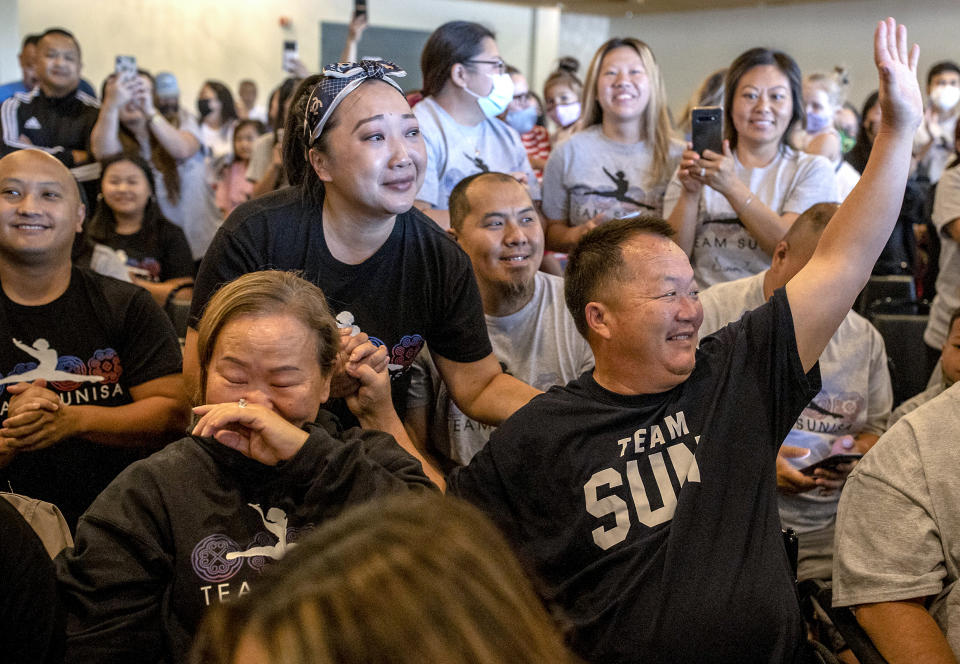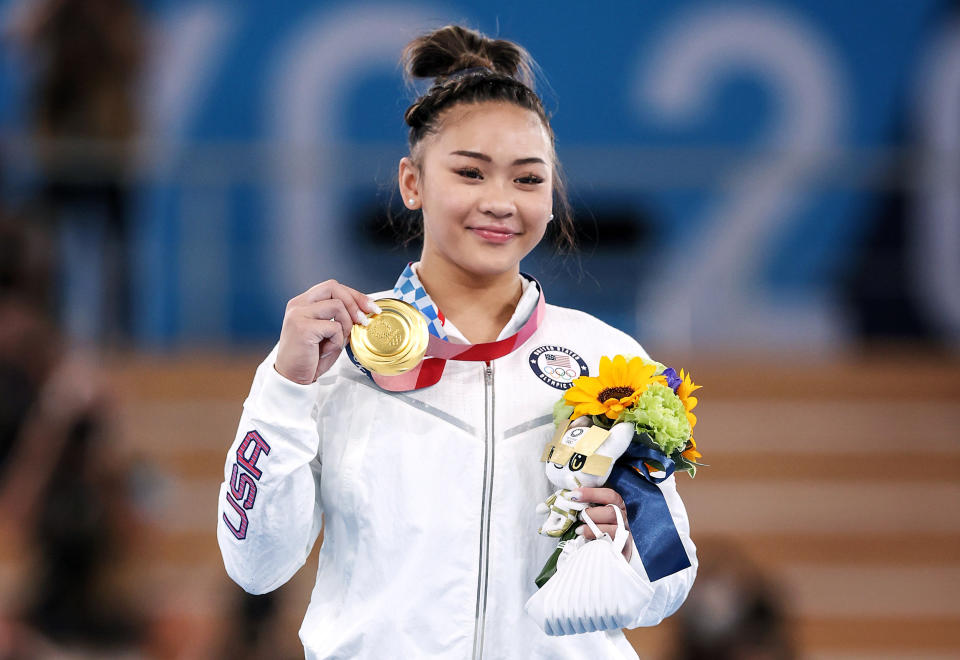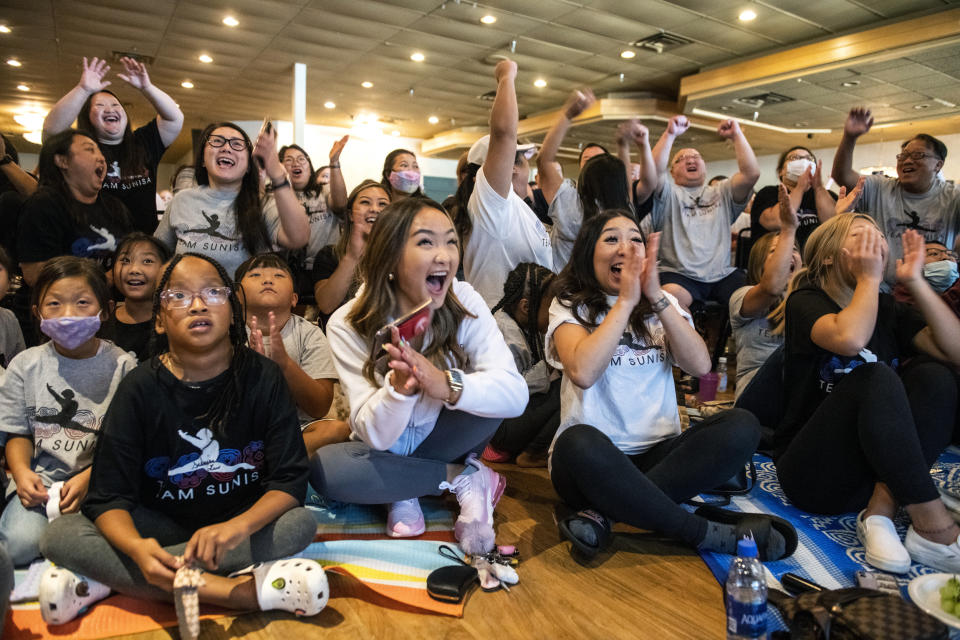Hmong Americans are often obscured by model minority myth. Why Suni Lee's win means so much.
- Oops!Something went wrong.Please try again later.
The family of Olympic gymnast Sunisa Lee, who’s Hmong American, erupted in hugs and cheers Thursday the moment she won gold in the women’s individual all-around gymnastics final, a reaction that reverberated across the Hmong community, a predominantly refugee group.
Experts say both the struggles and achievements of the Hmong community, an ethnic group with origins in Southeast Asia, have long been shrouded in decades of model minority stereotypes attached to the greater Asian American diaspora. So Lee’s win is far more than another addition to the nation’s medal count.

For many Hmong people, “there is no other country than the U.S.,” Kham Moua, director of national policy at the Southeast Asia Resource Action Center, told NBC Asian America.
“We don't have any significant ties anymore, at least the population here, to really any other country. This is really our country. This is our home,” Moua, who woke up before dawn every day to watch Lee compete, said. “My Facebook has been just filled with posts about Suni from Hmong folks all over the country. It's super exciting.”
In the past, Lee has gushed about her tight-knit community in Minnesota, which boasts a Hmong population of roughly 66,000, many of whom ended up in the area due to refugee resettlement. Though the group’s origins in the U.S. began roughly a half-century ago, fleeing war and genocide, experts say its story has been obscured by tropes and images of wealthy Asian Americans who enjoy a much higher degree of privilege compared to that of the community.
About 60 percent of Hmong Americans are low-income and about a quarter live in poverty, according to a 2020 SEARAC report. Compared to all other racial groups, Hmong Americans fare the worst across nearly all measures of income. When it comes to educational attainment, almost 30 percent of Southeast Asian Americans haven’t completed high school or passed the GED tests, compared to the 13 percent of the general population who have experienced the same, the report said.
Zoua Vang, associate professor of sociology at McGill University, in Canada, said many of these structural inequalities can be traced back to the United States' treatment of refugees following what has become known as the “secret war” of the 1960s. The U.S. had recruited many members of the Hmong community in Laos to fight on their behalf. Though the objective was to stave off communist control in the country, Laos fell to the Pathet Lao, communist national forces, in 1975. When U.S. troops pulled out, many Hmong fled for Thailand and various refugee camps before resettling across America.

“Certainly a lot of people, and I would count myself in this camp, feel that the government has let us down in terms of its obligations to help Americans, Hmong immigrants more generally, resettle and thrive in America,” Vang said. “The U.S. government has basically, like it does to most immigrants once they're here, stopped their responsibility to help these immigrants integrate into society.”
Hmong veterans continue to struggle with the lack of equal recognition and benefits for their sacrifices compared to U.S. vets, Vang said, which has become a “long-standing fight and struggle for people of that generation.”
With little government support, responsibility fell on private organizations and religious institutions to help the refugees, Vang said. Many Hmong Americans were forced to turn to or create their own support networks.
“Suni is so different from all those narratives because, certainly, there are echoes of war and trauma in her family's narrative. Her narrative is not a war narrative; it's a narrative about success,” Moua said. “We are talking about her as an individual, as an American, and quite honestly, it's so different from what we've seen. It's a positive narrative, too.”
However, experts stress that though Lee’s story is one of achievement and grit, it’s important that her narrative does not further perpetuate the idea that such extraordinary accomplishments are inevitable by just “pulling yourself up by the bootstraps.” Lee’s success isn’t so much proof of the opportunities or meritocracy in the U.S. but more so a reflection of the resilience of her community, they said.

While Lee’s family couldn’t afford a balance beam, her father built one himself, installing it in the backyard where it sits to this day, she told NBC’s “TODAY” show. Each year, the community held a fundraiser for the gymnast, chipping in so she would be able to compete competitively in the sport.
“The community is always right behind her,” Lee’s father told the Star Tribune. “Without that, Sunisa wouldn't be here. They're so supportive of her."
Moua said the existence of so many people of color on Team USA is a testament to those communities themselves, like the Hmong. Government documents from the secret war era once interpreted the Hmong, an oral culture, as “preliterate,” “meaning that they just can't learn, can't acclimate, can't become accustomed to the U.S,” he explained. Fast-forward to Lee’s win, and a much different image is projected on the Olympic podium.
“I think it is amazing that the Hmong community, just 45 years ago, was considered too ‘preliterate’ to even be accepted into the U.S. And yet, here we are today, with a Hmong American representing our country on an international stage winning gold,” he said. “I think it speaks more to the power of our community to love and support each other.”
Of course, Vang said, amid conversations about Lee’s community, the gymnast’s own strength must not be forgotten.
“It would be remiss to not just mention the resilience of Suni herself, certainly embedded within her family and then the larger community, but it takes a lot to get to where she's at,” Vang said. “That is personal resilience, in addition to the community resources that she may have drawn upon, to get to where she is.”
Vang said she hopes when people see Lee’s story, they’ll be prompted to put more resources and investment into communities like the Hmong.
“If we put investments and resources, what amazing diversity can we see on the world stage representing America, and how many more unsupported untapped talent is in communities of color, and the Hmong community,” Vang said.

